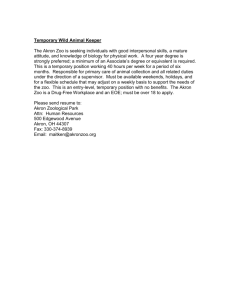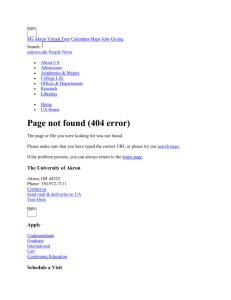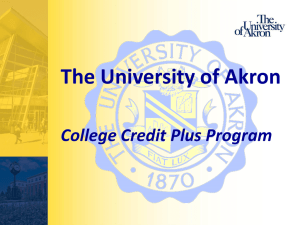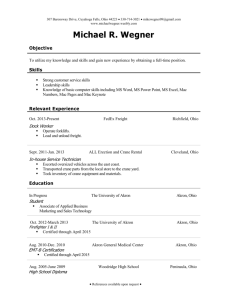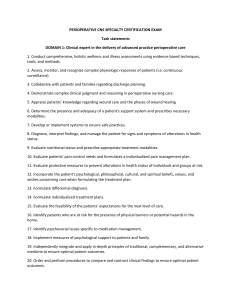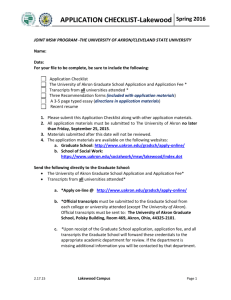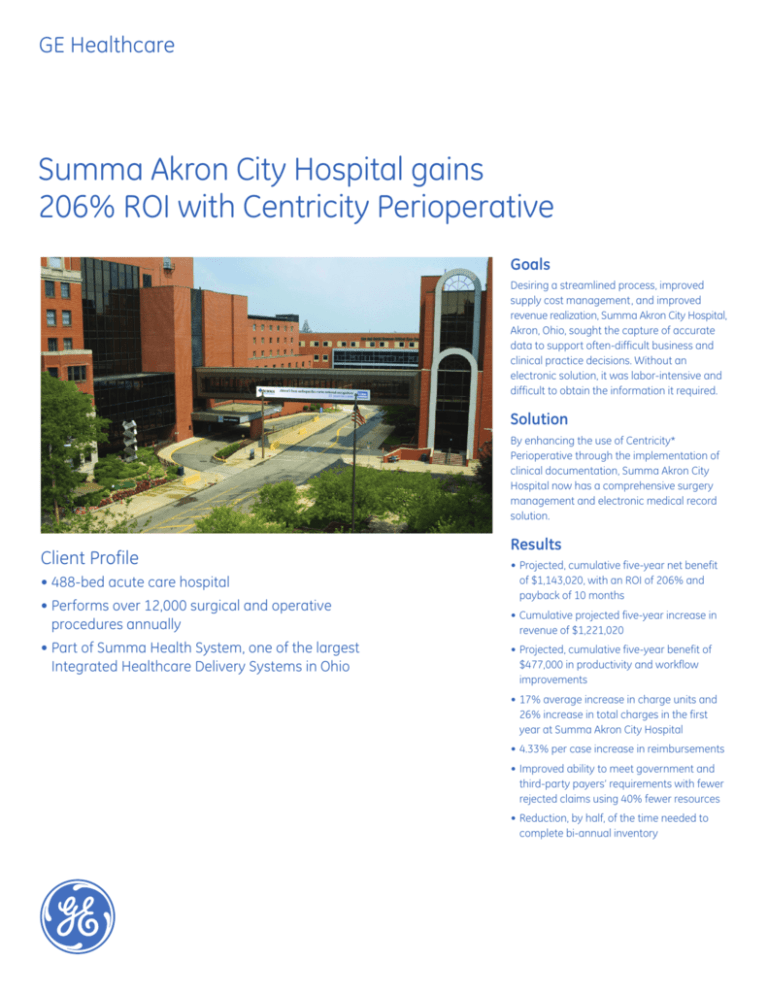
GE Healthcare
Summa Akron City Hospital gains
206% ROI with Centricity Perioperative
Goals
Desiring a streamlined process, improved
supply cost management, and improved
revenue realization, Summa Akron City Hospital,
Akron, Ohio, sought the capture of accurate
data to support often-difficult business and
clinical practice decisions. Without an
electronic solution, it was labor-intensive and
difficult to obtain the information it required.
Solution
By enhancing the use of Centricity*
Perioperative through the implementation of
clinical documentation, Summa Akron City
Hospital now has a comprehensive surgery
management and electronic medical record
solution.
Client Profile
• 488-bed acute care hospital
• Performs over 12,000 surgical and operative
procedures annually
• Part of Summa Health System, one of the largest
Integrated Healthcare Delivery Systems in Ohio
Results
• Projected, cumulative five-year net benefit
of $1,143,020, with an ROI of 206% and
payback of 10 months
• Cumulative projected five-year increase in
revenue of $1,221,020
• Projected, cumulative five-year benefit of
$477,000 in productivity and workflow
improvements
• 17% average increase in charge units and
26% increase in total charges in the first
year at Summa Akron City Hospital
• 4.33% per case increase in reimbursements
• Improved ability to meet government and
third-party payers’ requirements with fewer
rejected claims using 40% fewer resources
• Reduction, by half, of the time needed to
complete bi-annual inventory
“With Centricity Perioperative’s Clinical Documentation, we have
significantly improved our billing and inventory functionality with
fewer dedicated resources.”
Rob McCulloch
Senior Application Analyst
Clinical Information Systems
Summa Akron City Hospital
The perioperative department is one of the major financial
drivers responsible for the long-term success and sustainability
of a healthcare facility. Perioperative services often account
for more than 50 percent of a healthcare facility’s margin, as
well as 30 to 40 percent of its expense. In an environment of
healthcare reform, economic uncertainty, and the continued
push toward an integrated electronic health record (EHR),
these departments face major capital and operational budget
pressures. Even minor changes to reimbursement can
significantly impact a surgical service’s—and organization’s—
profitability.
Proactively addressing these challenges depends on having
access to the right data to help support business and patient
services decisions. This helps identify opportunities for
improvement that optimize workflow. But at Summa Akron City
Hospital, this information was difficult to obtain, as data had to
be manually extracted and analyzed from multiple locations —
including material management; scheduling; and admissions,
discharge and transfers (ADT) systems.
A robust, integrated, and optimized perioperative information
system would help ensure access to the operational and
clinical data that the perioperative department needed.
Summa Akron City Hospital added clinical documentation
features with integrated clinical and resource logic to its
Centricity Perioperative system to create a comprehensive
perioperative information and EHR solution.
Within one year of going live with the clinical documentation
features, Summa Akron City Hospital realized considerable
operational improvements and increased staff satisfaction.
“With Centricity Perioperative’s clinical documentation features,
we have significantly improved our billing features and
inventory functionality with fewer dedicated resources,” says
Rob McCulloch, Senior Application Analyst, Clinical Information
Systems, Summa Akron City Hospital.
Reduced inventory costs
Prior to implementing Centricity Perioperative's clinical
documentation features, supply management was difficult and
labor intensive. Over time, the item file/resource catalog had
become corrupted. Many items were missing or duplicated,
some products were inactive, and descriptions were
incomplete or inaccurate. Using Centricity Perioperative and
adopting a standard nomenclature, Summa Akron City Hospital
was able to remove thousands of duplicate or inactive items,
providing for a more accurate and lean item master/resource
catalog. Now Summa Akron City Hospital can take a snapshot
of its inventory—including stock, non-stock, and consignment
resources—reducing, by half, the time it normally takes to
complete a bi-annual inventory count.
Revising the resource catalog also helped improve the supply
procurement process, which had been segmented in individual
department silos. Working with the materials management
system, procurement of inventory items along with the correct
unit and cost can now be easily identified and maintained
using a standard Health Level Seven (HL7) interface. Having
access to accurate cost and procurement information helps
reduce the time needed to assign CDM and HICPS codes, as
well as virtually eliminating charge transcription and legibility
errors.
Automated perioperative pathway and procedure-specific
record templates, an integrated resource catalog, doctor’s
preference cards, and auto-populated clinical consumption
tracking have increased nursing staff satisfaction. With
increased preference card and casepick/costing accuracy,
nurses spend less time on non-clinical activities and more
time on patient-specific activities.
Charge by exception
The clinical documentation features use clinical logic to
optimize the documentation and charge-by-exception
processes. Using the automated charge-by-exception utilities,
perioperative services has reduced documentation time and
post-case review and audit, while more efficiently meeting
regulatory and professional record requirements.
What used to require two staff members now only requires
one. The hospital was able to allocate these key resources to
other roles for additional operational improvements. “Our
inventory and billing teams are able to work smarter and
faster, while providing more accurate reports,” says Ron
Peterson, RN, Billing Specialist/Supply Supervisor. “We better
meet government requirements and have fewer rejected
claims using far fewer resources.”
Summa Akron City Hospital has reduced the time it takes
to complete a bi-annual inventory count by 50%.
Calculating total procedure cost
Centricity Perioperative calculates total procedure cost—
including breakouts of supplies and capital equipment—for a
more accurate accounting of items used during a procedure. It
also provides point-to-point implant and tissue tracking
capabilities, eliminating the need for a third-party tissue
tracking application.
Nurses no longer have to guess about what items should be
charged or try to remember what was used during a procedure.
The information system automatically records all chargeable
items using intelligent charge rules. These are based on facility
requirements and can include department, facility inpatient/
outpatient, and procedure parameters taken directly from the
integrated scheduling and nursing record.
Improved reporting
Centricity Perioperative's robust reporting capabilities have
also spurred improvement. “We were able to identify ways to
optimize the schedule and reduce overtime by implementing
opportunities identified through the reporting tools,” says Rose
Gearhart, Senior Application Analyst, Surgical Services. “We
also have been able to identify and improve efficiencies such
as first case starts, turnover times, and the ability to audit time
out activities, which went from minimal manual audits to over
700 electronic reviews.”
In addition to standard reports, Summa Akron City Hospital
also benefited from the user-friendly SAP® BusinessObjects™
(BOA) Online Analytics Processing (OLAP) reporting tool
provided and supported in conjunction with Centricity
Perioperative. BOA reporting intelligence provides usable,
accessible data to drive both operational and clinical decisions.
“Using the robust reporting utilities, administrators can review
data and trends,” says McCulloch. “Data collected is unbiased
and can be used to justify improvements in workflow, staffing,
and resource utilization.”
Centricity Perioperative's comprehensive reporting tools helped
Summa Akron City Hospital gain efficiencies by reviewing the
total costs of like procedures and working with doctors and
payers to ensure consistent service delivery and billing. By
querying multiple parameters, Summa Akron City Hospital can
identify the true average case costing of a procedure—even for
patients not covered by insurance. This may become even
more important as healthcare insurance reform may have a
significant impact on which procedures and services drive
operational and clinical decisions.
With the ability to capture data and to use the data for actual
process improvement, Summa Akron City Hospital feels
Centricity Perioperative has ultimately paid for itself. Since
implementation, Centricity Perioperative has helped maximize
surgical suite use, cut costs, reduced resource allocation,
increased charge capture, and fostered other clinical and
service improvements.
The bottom line for Summa Akron City Hospital—$1.1 million in
net benefits.
By implementing clinical documentation features in Centricity
Perioperative, Summa Akron City Hospital optimized billing and
inventory using fewer dedicated resources, while realizing
improved charge and revenue capture.
Cumulative Five-Year Net Benefit = $1,143,020
Cumulative Net Benefit
$1,200,000
$1,000,000
Workflow
Savings
28%
$800,000
$600,000
Reimbursement
Increase
72%
$400,000
$200,000
$0
Year 1
Year 2
Year 3
Year 4
Year 5
Results summary
• Increasing reimbursements—an average of 4.33% per case
• Improving charge capture in the Specialty Surgery Center—
increasing the average charge units by 36.8% per case for
an increase in total charges of over 16% per case
• Realizing an average increase of 17% in charge units and an
increase of over 26% in total charges in the first year of
implementation at Summa Akron City Hospital
• Better meeting government and third-party payer requirements
and having fewer rejected claims using 40% fewer resources
As a result of the increased reimbursements and charge
capture, the hospital will see a projected, cumulative five-year
increase in revenue of $1,221,020. In addition, moving from a
paper-intensive workflow to an integrated electronic process
leads to an improved workflow and increased productivity,
resulting in a projected, cumulative five-year benefit of
$477,000.
Overall, Summa Akron City Hospital will see a projected,
cumulative five-year net benefit of $1,143,020, with a return on
investment of 206 percent and a payback period of 10 months.
The following chart provides a detailed, five-year analysis.
• Completing bi-annual inventory in 50% less time
Project summary
Return on Investment
Payback (in months)
Cumulative Net Value
Net Present Value
Project costs
Investment
Ongoing costs
Total project costs
Benefits
Reimbursement increase
Workflow savings
Total benefits
206%
10
$1,143,020
$811,735
Start up
$150,000
Financial analysis
Net Value
Cumulative Net Value
Year 1
Year 2
Year 3
Year 4
Year 5
$150,000
$81,000
$81,000
$81,000
$81,000
$81,000
$81,000
$81,000
$81,000
$81,000
$81,000
Start up
$200,000
$90,000
$290,000
Year 1
$220,000
$92,700
$312,700
Year 2
$242,000
$95,400
$337,400
Year 3
$266,200
$98,100
$364,300
Year 4
$292,820
$100,800
$393,620
Year 5
$1,221,020
$477,000
$1,698,020
Start up
-$150,000
-$150,000
Year 1
$209,000
$59,000
Year 2
$231,700
$290,700
Year 3
$256,400
$547,100
Year 4
$283,300
$830,400
Year 5
$312,620
$1,143,020
TOTAL
$150,000
$405,000
$555,000
Return on Investment (ROI) is the percentage return expected over a specified period of time. ROI is the total benefit divided by the total costs. This ROI metric is good for assessing
the multiplier provided by the benefits relative to the total investment and costs.
Net Present Value (NPV) represents the cumulative present value of the expected return of a project over a specified period of time minus the initial costs of the project. This figure
provides visibility on the actual value of a project, taking into consideration the time value of money—the ongoing benefit of a project in today’s money. NPV tells you the magnitude
of the project and if the project generates a profit.
Payback Period (or breakeven) is the timeframe it takes for the project to yield a positive cumulative cash flow. Payback period is a key measurement of risk but does not take into
account cash flows after the payback period.
ROI, NPV and Payback should be used in conjunction to understand the rate, size and timing of the return.
Net Value (or Net Benefit) is the benefit delivered to the organization for the investment made in the project. Net Value is calculated by taking the total benefit minus the project costs.
GE Healthcare
540 West Northwest Highway
Barrington, IL 60010
U.S.A.
www.gehealthcare.com
©2011 General Electric Company – All rights reserved.
General Electric Company reserves the right to make changes in specifications
and features shown herein, or discontinue the product described at any time
without notice or obligation. This does not constitute a representation or
warranty or documentation regarding the product or service featured.
*GE, the GE Monogram, Centricity and imagination at work are trademarks
of General Electric Company.
SAP Business Objects is a trademark of SAP AG in Germany and in several
other countries.
GE Healthcare, a division of General Electric Company.
imagination at work
ITD-0165-01.11-EN-US

